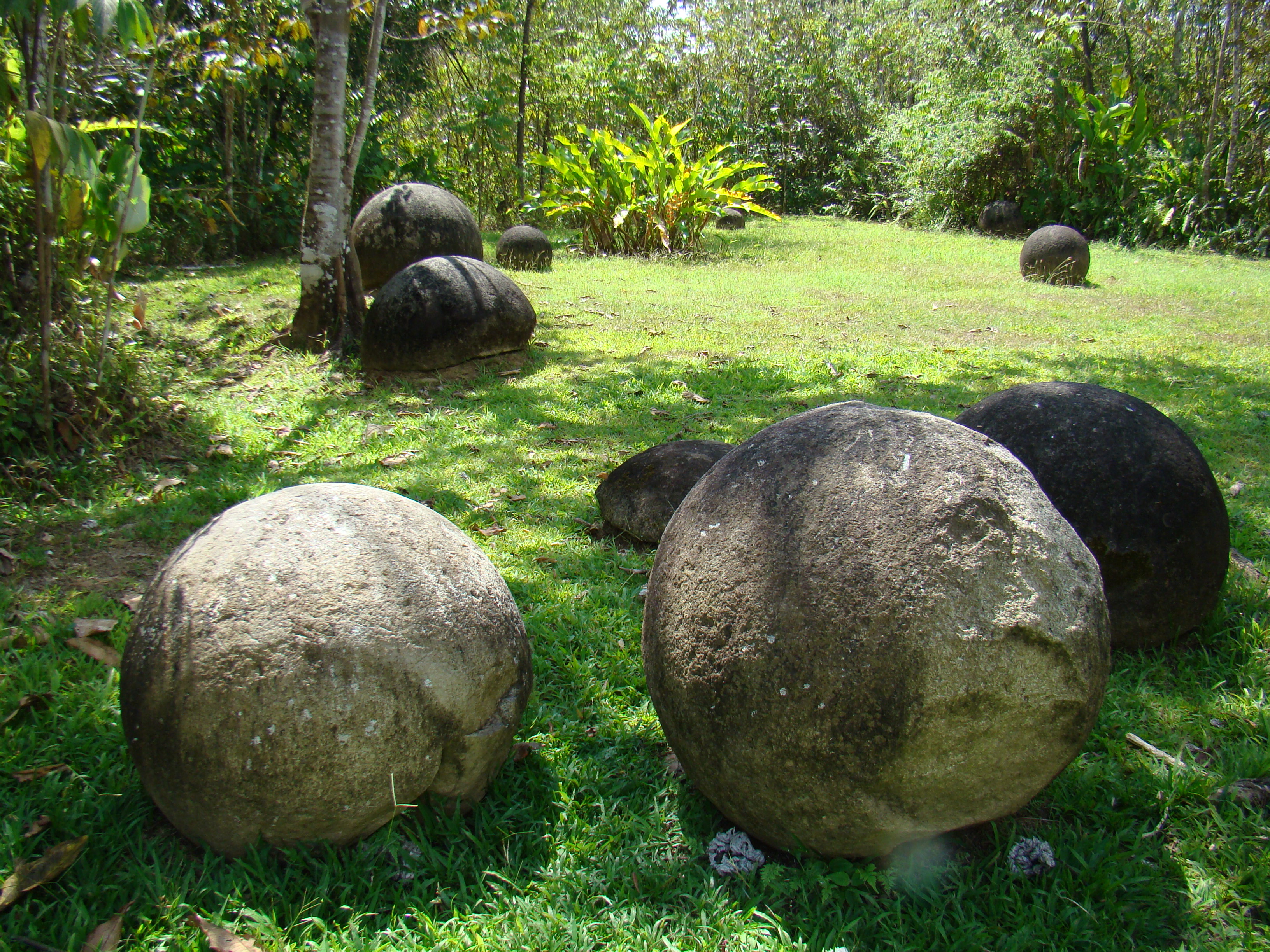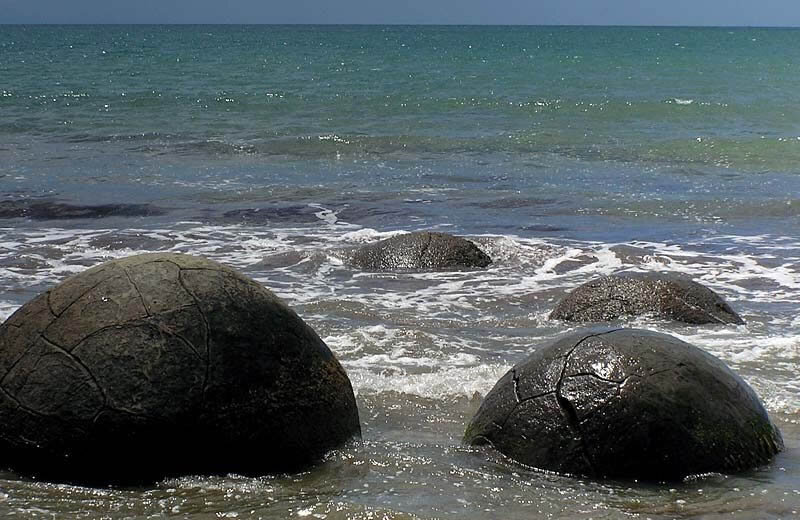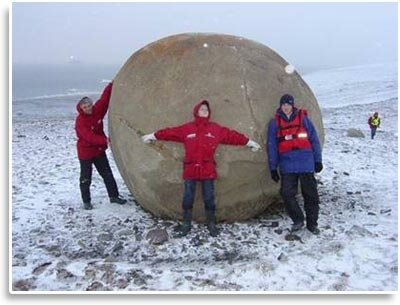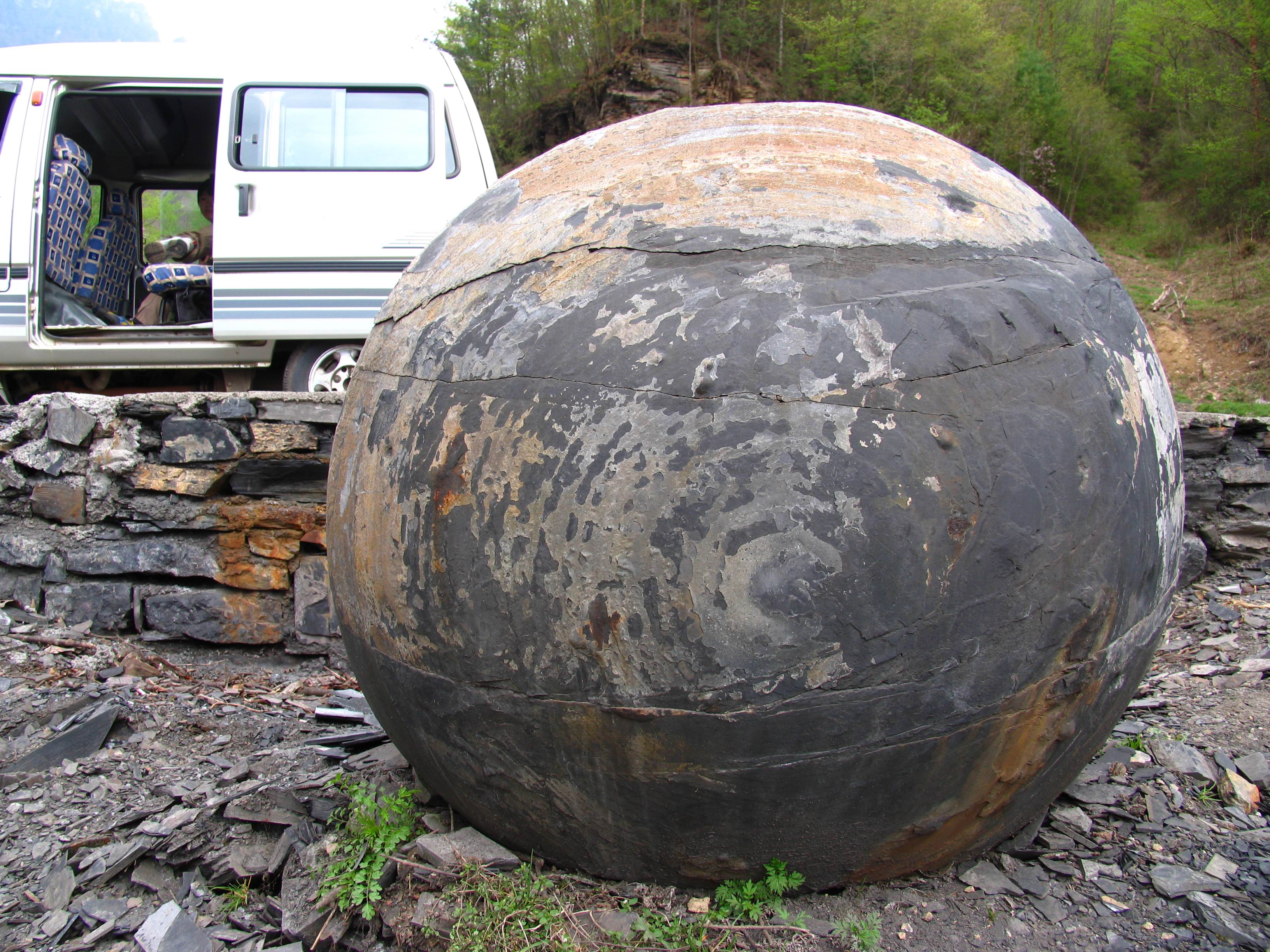
In the 40s of the twentieth century in the jungle of Costa Rica was an interesting discovery. Workers United Fruit Company, to cut down thickets of tropical jungle under banana plantations, unexpectedly stumbled upon a giant stone statues correct spherical shape.
The biggest reach three meters in diameter and weighed about 16 tons. And the youngest children were no more balls, with only ten centimeters in diameter. Balls were placed singly and in groups of three to fifty pieces, sometimes forming geometrical figures.
In 1967, one engineer and lover of history and archeology, who worked in Mexico in the silver mines, according to the American scientist that discovered in the mines of the same balls, but much larger sizes.
After some time on the plateau Aqua Blanca near the township of Guadalajara (Guatemala) at an altitude of 2000 m above sea level archaeological expedition has found hundreds more stone balls.
Similar stone balls were also found near the town of Aulaluko (Mexico), in Palma Sur (Costa Rica), Los Alamos and New Mexico (USA), on the coast of New Zealand, Egypt, Romania, Germany, Brazil, Kashkadaria region. Kazakhstan and Franz Josef Land.
With a light hand, Erich von Däniken balls dubbed "balls that were played the gods."

Clickable 3000 px
Their appearance some geologists attributed volcanic activity. Balloon ideal shape can be formed when volcanic magma crystallization occurs uniformly in all directions.
According to lead researcher of the Central Research Institute of Geology of rare and nonferrous metals candidate of geological-mineralogical sciences Elena Matveeva, balls could come to the surface as a result of the so-called eksofolizatsii - weathered, working in areas with large daily swings. However, where the temperature is more stable, find similar beads, but underground.
However, as it may sound convincing these assumptions, the final clue of the phenomenon to this day do not. First of all, they can not explain the origin of granite balls.
Furthermore, the same could not properly be positioned ancient volcanoes a plurality of shapes of spheres having, besides, traces of polishing! Although a significant portion of these balls seem to really have a purely natural origin, some instances, such as balls of Costa Rica, do not fit into the framework of this theory, because they have clear signs of leveling and grinding. Now in Costa Rica found more than 300 stone spheres.
 The first scientific study of the balls was undertaken by Doris Stone immediately when you open them working United Fruit Company. The results of her study were published in 1943 in «American Antiquity», the leading scholarly journal of archeology in the United States.
The first scientific study of the balls was undertaken by Doris Stone immediately when you open them working United Fruit Company. The results of her study were published in 1943 in «American Antiquity», the leading scholarly journal of archeology in the United States. Samuel Lothrop, a staff archaeologist Museum of Archaeology and Ethnography Peabody Harvard University, conducted a major field work research balloon in 1948, Final Report on the results of his research have been published by the Museum in 1963.
It contains maps of the areas where the balls were found, detailed descriptions of pottery and metal objects found near the balls, and lots of photos, measurement data and pictures of balls, their relative position and stratigraphic contexts.
On further study balls archaeologist Matthew Stirling was reported in the pages of National Geographic in 1969.
In the 1980s, land with balls were investigated and described by Robert Droletom during excavations conducted them.
In the late 1980s and early 1990s, Claude Baudez and his students from the University of Paris returned to the excavations Lothrop to undertake a more thorough analysis of pottery and get a more precise dating of the stratigraphic contexts balls. This study was published in Spanish in 1993, with a summary in English, which appeared in 1996
Also in the early 1990s, John Houps conducted fieldwork around Golfito, documenting the most eastern of the known specimens of these balls. At the same time, Enrico Dal Lagoa, a student at Kansas State University, defended the thesis on balls.
The most thorough study of the spheres after Lothrop, however, began field work undertaken in 1990-1995 archaeologist Iphigenia Kvintanilloy under the auspices of the National Museum of Costa Rica.
She was able to dig up a few balls in their initial state. As of 2001 the main part of the information that it has gathered, has not yet been published, although it was the subject of her graduate studies at the University of Barcelona.

The results of archaeological research are presented in the following publications:
Lothrop, Samuel K. Archaeology of the Diquis Delta, Costa Rica. Papers of the Peabody Museum of Archaeology and Ethnology, Vol. 51. Harvard University, Cambridge. 1963
Stone, Doris Z. A Preliminary Investigation of the Flood Plain of the Rio Grande de Terraba, Costa Rica. American Antiquity 9 (1): 74-88. 1943
Stone, Doris Z. Precolumbian Man Finds Costa Rica. Peabody Museum Press, Cambridge, Massachusetts. 1977
Baudez, Claude F., Nathalie Borgnino, Sophie Laligant & Valerie Lauthelin Investigaciones Arqueologicas en el Delta del Diquis. Centro de Estudios Mexicanos y Centroamericanos, Mexico, DF 1993
Lange, Frederick W. (ed.) Paths Through Central American Prehistory: Essays in Honor of Wolfgang Haberland. University of Colorado Press, Boulder. 1996

In contrast to the geologists, archaeologists recognize artificial origin balls of Costa Rica.
Almost all of the balls are made of granodiorite, a hard lava rock outcrops which are located in the foothills suburbs Talamanca. There are a few copies made of coquina, a solid material like limestone, which is formed of shells and sand in coastal sediments. According to archaeologists, the balls were manufactured by machining of round boulders to a spherical shape in several stages. At the first stage the boulders were alternately strong heating and cooling, resulting in the top of the boulders was flaking off like the leaves of the bulb.
Granodiorite, from which they are made, have been identified as yet bears traces of strong temperature fluctuations. When they approached the shapes of the area, it is further treated stone tools from a material of the same hardness. At the final stage of the balls were placed on the base and polished to a shine.

Often in the media appear stating that these balls have a perfect spherical shape with an accuracy of 2 millimeters. In reality, for such categorical statements for no reason.
The fact that no one has ever measured the balls of Costa Rica with a similar degree of accuracy. Lothrop wrote:
"To measure the circumference, we used two methods, none of which is entirely satisfactory. When large balls were buried deep in the ground, it might take a few days to dig a trench around them. Therefore, we investigated only the top half and then measure two or three diameters with tape and a plumb. Measurements have shown that small specimens, typically a diameter of 2 to 3 feet (0.6-0.9 meters) in diameter, the differences are one or two inches (2.5-5.1 cm). "

Lothrop also measured the balls that have been completely removed from the land, putting in five circles a piece of tape. He writes:
"Obviously, the big balls is a product of the highest quality, and they were so nearly perfect that the diameter measurement tape and a plumb line showed no difference. Therefore, we measured the circumference of the horizontal and, as far as possible, at an angle of 45 degrees to the four cardinal points.
We do not usually measured vertical circle as large balls were too heavy to move. This procedure was not as easy as it sounds, because a few people had to keep the tape, and all the measurements had to be checked. Since the difference in diameter was too small to be detected by the eye even with a plumb line, the diameters were calculated mathematically. "
It is clear that the differences are "too small to be detected by eye" can not be translated into a statement about the accuracy of "within 2 millimeters."
In fact, the surface of the balls is not completely smooth and has irregularities, clearly greater than 2 millimeters in height. Moreover, balloons are often noticeable significant surface damage. Therefore, it is impossible to determine whether they could be flat at the time of manufacture.
In fact, no one knows for sure what exactly these balls were made.

By the time the first Spanish conquests balls no one was producing, and they remained completely forgotten until they were rediscovered in the 1940s.
Some archaeologists believe that the balls were placed in front of houses of noble people as a symbol of their power, or secret knowledge.
There is also a view that the very creation and movement of the balls had a great religious or social significance, no less than their final location.
As already mentioned, a large part of stone balls settled by some groups. Some of these groups form a straight or sinuous lines, triangles and parallelograms. One group of four balls was determined aligned along a line oriented to magnetic north.
This led Ivar Zappa to the suggestion that they may have been posted by people familiar with the use of magnetic compasses, or astronomical orientation.
However, the hypothesis Ivar Zappa that group of stone balls are navigational devices pointing to Easter Island and Stonehenge, it is ill-founded.
This group of four takes balls (as measured Lothrop) only a few meters, which is not enough to avoid errors in the drafting of a plan for such long distances.
In addition, with the exception of balls located in the Isla del Caso, most of the balls are too far from the sea, to be useful for ocean navigators.
Version is also found that the location of stone balls reminiscent of some of the heavenly constellations. In accordance with the balls of Costa Rica some "researchers" is often considered a kind of "Planetarium", "observatory" or guide the spacecraft.

However, despite the attractiveness of these versions to the public, it should be noted that the authors of these versions is relied on their imagination, rather than on the results of field studies.
Many of the balls, some of them in groups, have been found at the top of embankments. This has led to speculation that they may have remained inside the buildings, built on the tops of mounds, making it difficult to use them for observation.
Moreover, to date, all (except a few) have already been destroyed, so the measurements conducted nearly fifty years ago, can not be checked for accuracy.
Virtually all known balls were moved from their original location in the agricultural work that destroyed information about their archaeological contexts and possible groups.
Part balloon was blown up and destroyed by local treasure hunters who believed the fables that the balls contain gold. Balls rolled into ravines and gorges, or even under the water at the seaside (as in Isla del Caso).
Now a significant part of the balls used as ornaments unpretentious lawns. It is possible that at least some part of the balls also once used for similar purposes.
So, for example, is located off the Pacific coast to the border with Guatemala center ISAP that existed later Olmec, round balls of small size have been found near the small stone pillars, which could well serve for their stand.
Remains unknown, and the manufacture of the balls.

Since reliable methods of dating of stone artifacts now does not exist, archaeologists have to rely only on stratigraphic studies and determine the date of manufacture of the balls on the cultural relics found in the same deposits.
Found during the excavation of such remains are dated by archaeologists now range from 200 BC even before 1500 BC But even such a wide range can not be considered final.
The fact that the stratigraphic analysis always leaves a lot of doubt in the dating of these artifacts. Not least because if the balls are now moving from place to place, there is nothing to exclude the possibility of such a move and the balls at the same time, which gives the stratigraphy.
Consequently, the balls may well be far more ancient. Up to hundreds of thousands and millions of years (there are some hypotheses).
In particular, it is absolutely not ruled version, voiced by George Erikson and other researchers that the balls are more than 12 thousand years. With all the skepticism of archaeologists in relation to such date, it is not without foundation.
In particular, John mentions Houps balls in Isla del Caso, who are under water off the coast.
If these balls were not there already moved to a later time and were there originally, then put them back could only when the sea level was much lower than today. And it also gives them the age of at least 10 thousand years ...
Remains a mystery, and a method of transporting the balls (or blanks for them) - from their locations to the places of origin of the material intended for the manufacture of tens of kilometers, a significant portion of them in the swamps and thickets of tropical forest ...
The first report on the study of balls of Costa Rica archaeologist Doris Z. Stone ended by saying the words: "We have committed to carry spheres of Costa Rica to the unfathomable mysteries of megalithic". In this it is impossible to disagree ...
* *
Stone balls found in fact not only in Costa Rica. There were reports that such balls sailors Murmansk Shipping Company is located on the coast of the Arctic Ocean. And here it is - a snapshot of the balls on the coast of one of the islands of New Zealand:

Or here's the facts:
In 1969, in Germany, in the Eifel, in the explosion of the quarry slope rolled perfectly round ball with a diameter of five meters and weighing over 100 tons.
In Kazakhstan, the development of the sand pit with a large depth were dug several large stone balls.
The unique beauty of the balls have been found on the sides of the beam Bukobay Sol-iletsk area the Orenburg region.
Dozens more such stones were in a ravine five kilometers west of Zhirnovskaya Volgograd region. In 2002-2003, unfortunately, the most beautiful and expressive of them destroyed the local bulldozer petroleum, which stretched several pipelines.

Balls in the Volgograd region
Full of balls (up to 2 meters in diameter) on the Arctic island of Champa on Franz Josef Land. However, there are also some very tiny.
In October 2007, at a depth of 10-25 meters at the bottom of the Black Sea near Gelendzhik expedition "Kosmopoisk" found balls with a diameter of 0.7 to 1 meter. Smallest managed to raise and examine on the beach.
Geologists and historians have drawn the conclusion that the ball turned, artificial, and on its surface can be seen "ledge" and X-shaped propyl. Why did these balls that are too large for most gigantic powder guns and catapults for the biggest unknown.
BOGUCHANSKAYA balls does not claim to be the most mysterious. For more than 60 years, scientists scratching their heads over their more famous and massive counterparts - stone balls of Costa Rica (Central America), and other areas of South America.

Some BOGUCHANSKAYA balls are cut into slices.
Some balls at the time of detection looked as if they'd recently brought into place. Others were partially buried. Or barely sticking out of the ground. A few specimens found at a depth of two meters. No one dug deeper. Nevertheless, the impression that the balls would crawl out of the bowels.

Arctic island Champa - one of the most unique places in the world - all strewn with strange, perfectly round stones.
Without claiming to be the ultimate truth, you can make the following preliminary conclusions. Of course, the stones with Champa can be classified as globular concretions. Concretions - from the Latin word concretio - fusion thickening.
This contraction, mineral formations rounded form in sedimentary rocks. Centers such nodules may be grains of minerals, rock fragments, shells, teeth and bones of fish, plant residues.

Most of them are formed in porous sedimentary rocks - sands and clays. By the structure of the most frequent concentrically layered - as if composed of several shells.
They usually consist of calcium carbonates, oxides and sulfides of iron, calcium phosphate, gypsum, and manganese compounds.
Nodule formation goes something like this: on the walls there are growths that, growing towards each other, merge and form different shapes. Concretions in the world is dominated by spherical, disk-like, less often in the form of an ellipse or wrong - fused.

Opinions about the origin of the stone balls as much and researchers. According to Victor Boyarsky, each geologist, once visited Champa, he heard his explanation for this phenomenon.
Victor Boyarsky does not exclude That in the Franz Josef Land, there is A place Bustling center of spherical stones, "Do not be Surprised if the New expedition informed About anything like That. Geological In terms, this corner of the World can present A lot of unexpected Surprises. " Proximity mysterious Civilizations and Their Religious buildings like the pyramids, of course, Gives rise to A Supernatural hypothesis. Up to the Fact That the balls Were Made by Aliens from Outer Space, or, any of the Atlantis. Or, at least, under their leadership.
After some really Find traces of processing. And the inscription. And some of the balls of Costa Rica WAS Originally Laid out by some Ornaments - like Their Drawings matched the Location of the constellations.
HOWEVER, now rearranged Finds Carried out on personal monastery and Museums. And to Restore the picture is Possible No longer.
The famous researcher of anomalous and big dreamer Erich von Daniken Generally dubbed balls "balls Played That Were the gods." Football hinted. Although They are more Suitable for A game of golf or croquet. Champa Island, Franz Josef Land

Geologists Slightly Surprised balls. But Different Hypotheses have Been Incurred. - Aliens are here, of course, there is nothing - says Associate Professor of Geology and Geophysics, Irkutsk State University Alexei Korol'kov. - Most likely, this is the so-Called iron concretions. They are Formed by compacting sediments in the coal fields. In the middle of Them Often Find Organic Residues, Mineral or bacterial clusters That serve as "seed", while ITS growth.
Some Scientists Stress That the nodule Turns into A ball and Uniformly Increases When Substances are deposited in the rock, permeable Equally in all directions. And as the ancestral Home of the balls is Called the ocean Floor. Supposedly Formed around the Remains of shells, animal bones, and algae in soft sediments. Were And on the land When the Seabed rose.
But the Properties of Surrounding the rock are such That Education Become disks. Or even cylinders up to TENS Several of meters. And, both can Easily be taken for A MAN-Made Product. Cylinders, for example, the Count columns - the Remains of the buildings, which supposedly for many millions of years.
Someone sees the reason "sharoobrazovaniya" in the Crystallization of volcanic magma. Someone - A Foreign substance filling the voids - bubbles (Similar to the holes in Swiss cheese). And the appearance on the surface - in the Elementary weathering. Stone on Easter Island
